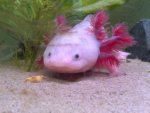Caudata.org: Newts and Salamanders Portal
Register a free account today to become a member! Once signed in, you'll be able to participate on this site by adding your own topics and posts, as well as connect with other members through your own private inbox!
Did you know that registered users see fewer ads? Register today!
-
Axolotls are illegal in California. Please read this thread for detailed information and links to the actual laws: https://www.caudata.org/threads/axolotls-are-illegal-in-california-here-are-the-relevant-laws.30779/
-
Did you know that registered users see fewer ads? Register today!
Cameleon like gill colour changes
- Thread starter russell
- Start date
- No one is chatting at the moment.
-
Shane douglas:with axolotls would I basically have to keep buying and buying new axolotls to prevent inbred breeding which costs a lot of money??+1
-
Thorninmyside:Not necessarily but if you’re wanting to continue to grow your breeding capacity then yes. Breeding axolotls isn’t a cheap hobby nor is it a get rich quick scheme. It costs a lot of money and time and deditcation+1
-
Clareclare:Would Chinese fire belly newts be more or less inclined towards an aquatic eft set up versus Japanese . I'm raising them and have abandoned the terrarium at about 5 months old and switched to the aquatic setups you describe. I'm wondering if I could do this as soon as they morph?+1
Clareclare:
Would Chinese fire belly newts be more or less inclined towards an aquatic eft set up versus...
+1


 Axolotl Enthusiast
Axolotl Enthusiast